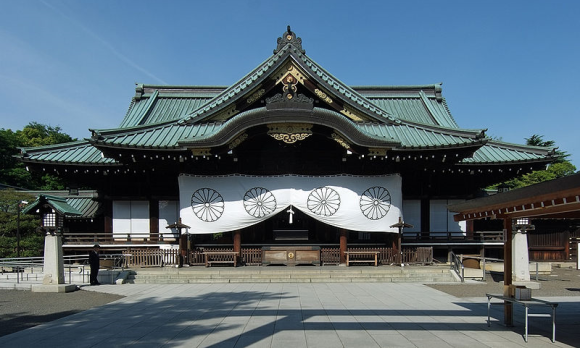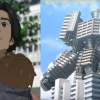
Explosion occurred at controversial Yasukuni religious site roughly two weeks ago.
Last month, on the morning of November 23, an explosive device was set off on the grounds of Yasukuni Shrine. Yasukuni, located in Tokyo’s Chiyoda Ward, enshrines the souls of all those who were killed fighting for Japan in conflicts that have occurred since the start of the country’s Meiji Period in the mid-19th century.
After being contacted by a construction worker who heard the explosion, the police conducted a search of the Yasukuni Shrine grounds on the 23rd, discovering a 30-centmeter (11.9-inch) square hole blown out of the ceiling of a public restroom, as well as four pipes bound together with a lead wire attached, scorched batteries, and what appeared to be a digital display. Thankfully, no injuries were reported, despite a larger than usual number of visitors being at the shrine to attend the annual Niinamesai rice harvest ceremony which was being held that day.
Upon examining surveillance footage recorded in the area, Tokyo Metropolitan Police claim to have identified Changhan Jeon, a 27-year-old Korean national, leaving the scene shortly after the explosion. Jeon had checked into a hotel in Chiyoda Ward on the night of November 22, but left Japan following the blast on November 23, departing Tokyo’ Haneda Airport on a flight back to Korea.
However, Jeon returned to Japan, again passing through Haneda Airport, on the morning of December 9. Upon arrival, he was met by the authorities and promptly arrested.
No motive has been suggested, but considering the sharply divided political opinions Yasukuni is a lightning rod for, displeasure at Japan’s military aggressions towards Korea in the first half of the 20th century is likely the supposition the police are operating under. Jeon has denied the charges, responding to questioning with the phrase “Yoku wakaranai” (“I don’t know” or “I’m not sure”), and remains in police custody.
Source: NHK News Web via Jin
Top image: Wikipedia/Wiiii

 Police respond to explosion, suspected bombing at Yasukuni Shrine in central Tokyo
Police respond to explosion, suspected bombing at Yasukuni Shrine in central Tokyo Foreign resident of Japan sentenced to eight months in prison for vandalizing Tokyo shrine
Foreign resident of Japan sentenced to eight months in prison for vandalizing Tokyo shrine Visiting a maximum security shrine at the foot of the Narita airport runway
Visiting a maximum security shrine at the foot of the Narita airport runway When will the sakura bloom in Tokyo? We visit the famous cherry blossom sample tree to find out
When will the sakura bloom in Tokyo? We visit the famous cherry blossom sample tree to find out Ramen restaurant’s English menu prices are nearly double its Japanese ones, denies discriminating
Ramen restaurant’s English menu prices are nearly double its Japanese ones, denies discriminating Top Japanese cosplayer Enako returns to Comiket after 6 years, creates mayhem with admirers
Top Japanese cosplayer Enako returns to Comiket after 6 years, creates mayhem with admirers Here’s what our bachelor writers ate over the New Year’s holiday in Japan
Here’s what our bachelor writers ate over the New Year’s holiday in Japan Japanese beef bowl chain Sukiya’s 2026 Smile Box lucky bag basically pays for itself
Japanese beef bowl chain Sukiya’s 2026 Smile Box lucky bag basically pays for itself What makes a good boss in Japan? Workers sound off in survey
What makes a good boss in Japan? Workers sound off in survey Buildings transform into giant robots in Japanese real estate company’s anime commercial【Video】
Buildings transform into giant robots in Japanese real estate company’s anime commercial【Video】 All-You-Can-Eat Fermented Soybeans for $8.50! Choose From Eight Types of Natto!
All-You-Can-Eat Fermented Soybeans for $8.50! Choose From Eight Types of Natto! Japanese thug wear from Birth Japan perfect for those breaking bad next year
Japanese thug wear from Birth Japan perfect for those breaking bad next year From Kyoto: The bicycle you can ride while wearing a kimono
From Kyoto: The bicycle you can ride while wearing a kimono The Purple Lucky Bag from Village Vanguard is an extra-large waste of money
The Purple Lucky Bag from Village Vanguard is an extra-large waste of money Starbucks Japan ready to get Year of the Horse started with adorable drinkware and plushies【Pics】
Starbucks Japan ready to get Year of the Horse started with adorable drinkware and plushies【Pics】 Hayao Miyazaki says Happy New Year to Studio Ghibli fans with new art for Year of the Horse
Hayao Miyazaki says Happy New Year to Studio Ghibli fans with new art for Year of the Horse Cup Noodle tries an authentic Jiro-style ramen, but something’s not quite right
Cup Noodle tries an authentic Jiro-style ramen, but something’s not quite right The best Starbucks Japan Frappuccinos we want to drink again in 2026
The best Starbucks Japan Frappuccinos we want to drink again in 2026 We revisited Sweets Paradise after a decade to see if Japan’s dessert buffet still delivers
We revisited Sweets Paradise after a decade to see if Japan’s dessert buffet still delivers That time Seiji called JASRAC to ask why he didn’t get paid royalties for his song being on TV
That time Seiji called JASRAC to ask why he didn’t get paid royalties for his song being on TV Pizza Hut Japan’s hot lucky bags are perfect for a New Year’s pizza party
Pizza Hut Japan’s hot lucky bags are perfect for a New Year’s pizza party Majority of Japanese mayors say foreign residents are essential but most see good and bad effects
Majority of Japanese mayors say foreign residents are essential but most see good and bad effects 7-Eleven Japan starts new temporary luggage storage service in over 300 branches
7-Eleven Japan starts new temporary luggage storage service in over 300 branches Disillusionment at Tsukiji’s tourist-target prices led us to a great ramen restaurant in Tokyo
Disillusionment at Tsukiji’s tourist-target prices led us to a great ramen restaurant in Tokyo Starbucks teams up with 166-year-old Kyoto doll maker for Year of the Horse decorations【Photos】
Starbucks teams up with 166-year-old Kyoto doll maker for Year of the Horse decorations【Photos】 Tokyo considering law requiring more trash cans following litter increase in heavily touristed area
Tokyo considering law requiring more trash cans following litter increase in heavily touristed area Tokyo’s Tsukiji sushi neighborhood asks tour groups to stay away for the rest of the month
Tokyo’s Tsukiji sushi neighborhood asks tour groups to stay away for the rest of the month Tokyo event lets you travel back in time, for free, to celebrate 100 years since Showa era start
Tokyo event lets you travel back in time, for free, to celebrate 100 years since Showa era start Japan may add Japanese language proficiency, lifestyle classes to permanent foreign resident requirements
Japan may add Japanese language proficiency, lifestyle classes to permanent foreign resident requirements Sanrio theme park in Japan announces plans to expand into a Sanrio resort
Sanrio theme park in Japan announces plans to expand into a Sanrio resort Lacquerware supplier to emperor of Japan and Pokémon team up for new tableware
Lacquerware supplier to emperor of Japan and Pokémon team up for new tableware Survey asks foreign tourists what bothered them in Japan, more than half gave same answer
Survey asks foreign tourists what bothered them in Japan, more than half gave same answer Japan’s human washing machines will go on sale to general public, demos to be held in Tokyo
Japan’s human washing machines will go on sale to general public, demos to be held in Tokyo Japan’s deadliest food claims more victims, but why do people keep eating it for New Year’s?
Japan’s deadliest food claims more victims, but why do people keep eating it for New Year’s? We deeply regret going into this tunnel on our walk in the mountains of Japan
We deeply regret going into this tunnel on our walk in the mountains of Japan Studio Ghibli releases Kodama forest spirits from Princess Mononoke to light up your home
Studio Ghibli releases Kodama forest spirits from Princess Mononoke to light up your home Major Japanese hotel chain says reservations via overseas booking sites may not be valid
Major Japanese hotel chain says reservations via overseas booking sites may not be valid Put sesame oil in your coffee? Japanese maker says it’s the best way to start your day【Taste test】
Put sesame oil in your coffee? Japanese maker says it’s the best way to start your day【Taste test】 No more using real katana for tourism activities, Japan’s National Police Agency says
No more using real katana for tourism activities, Japan’s National Police Agency says Starbucks Japan reveals new sakura drinkware collection, inspired by evening cherry blossoms
Starbucks Japan reveals new sakura drinkware collection, inspired by evening cherry blossoms Updated cherry blossom forecast shows extra-long sakura season for Japan this year
Updated cherry blossom forecast shows extra-long sakura season for Japan this year
Leave a Reply